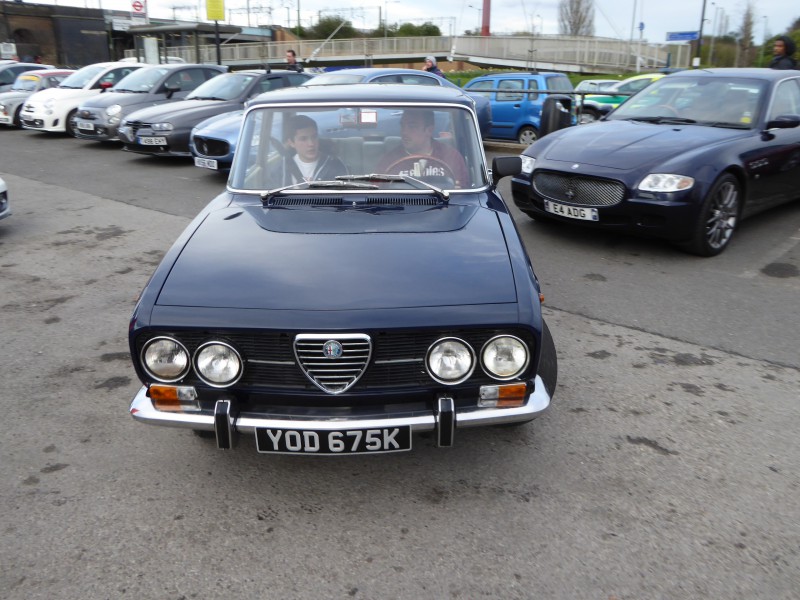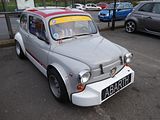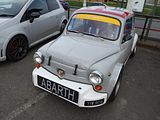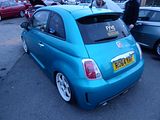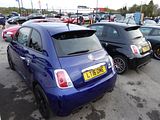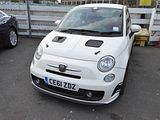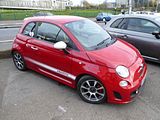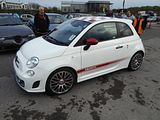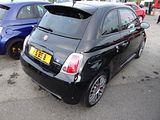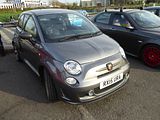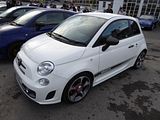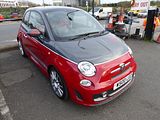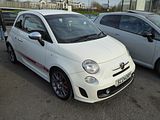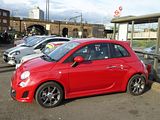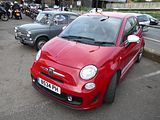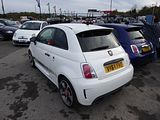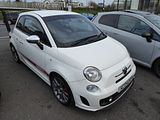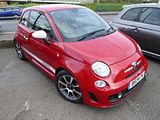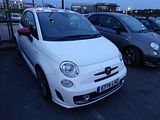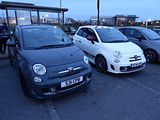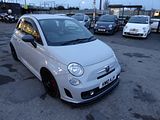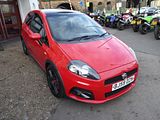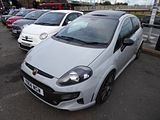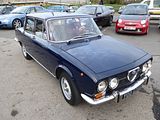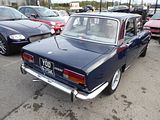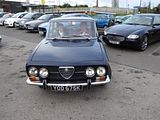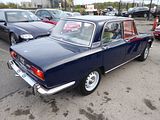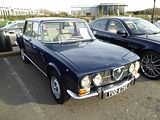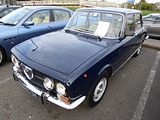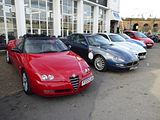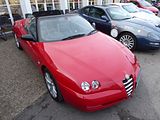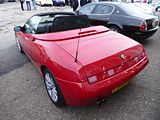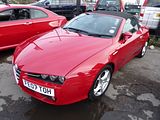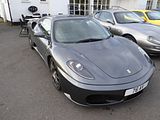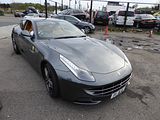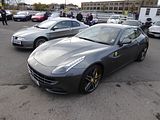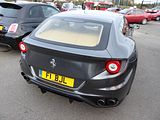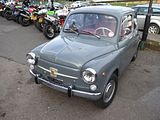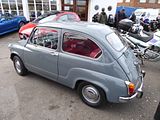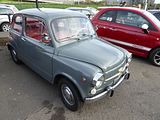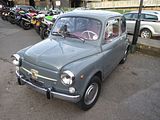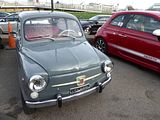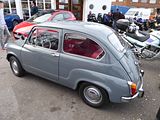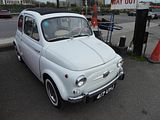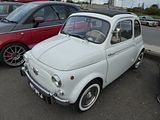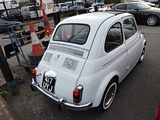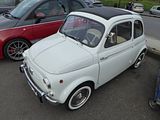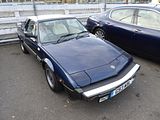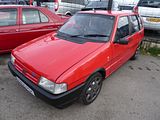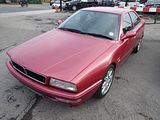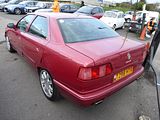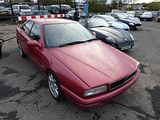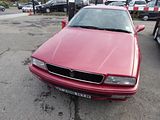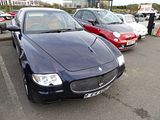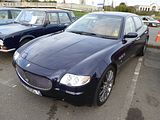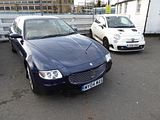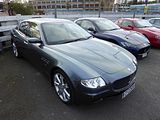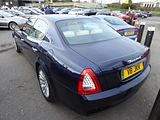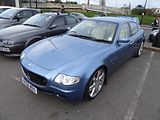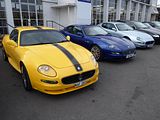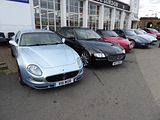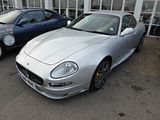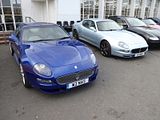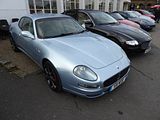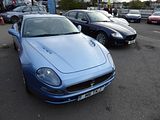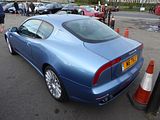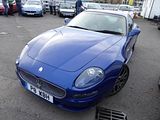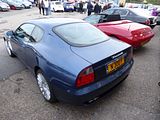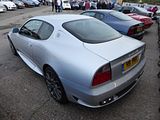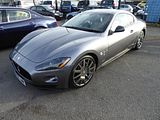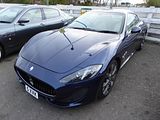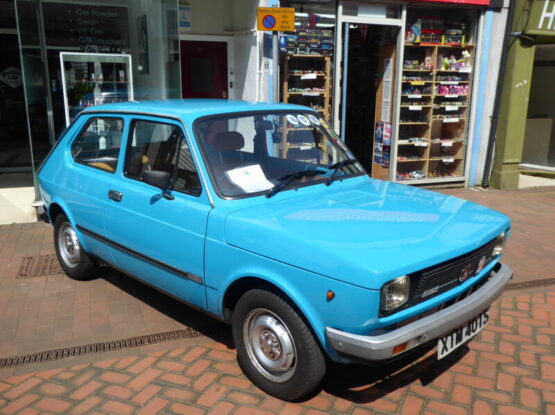The start of British Summer Time, at the end of March, is significant for all of us, as it signals the end of the winter months, and brings the promise of spring and summer, with warmer weather and daylight that extends beyond office hours. For the car enthusiast, that means that evening meets give the opportunity to see the cars in natural light, which in turn encourages a whole load more people to dig out their pride and joy and bring it along so others can enjoy it as well. Whilst the weather in Britain in April 2016 to date might give cause to wonder quite which season it really is, if indeed it is not all four season compressed into the space of a week, there is no denying the fact that it is now light until 8pm, and that always means that the Ace Cafe evenings, which do take place year around, enjoy a surge in popularity from this month for the next six or so. Indeed, the popular Italian Car Night, held still on the second Thursday of the month, as it has been for as long as I have been attending, marked the first occasion that I would be visiting this iconic venue in 2016. Logistics were such that I was unable to bring my Italian car, so the Audi had to stay a discrete distance up the road, but when I arrived, having enjoyed a completely clear run down from Warwick, there were already plenty of cars surrounding the perimeter of the venue and it did not take long before a few more came, to fill the middle bit. Although I have seen the Cafe packed out far more than this, enough cars were here to provide plenty of interest, and this was also a chance to catch up with many Ace Cage regulars who I had not seen for many a winter month. Here are the highlights of the evening:
ABARTH
Somewhat surprisingly, Abarth was not the most numerous marque of the evening, and that would not have changed even if I had brought along my car. Even so there was a good showing with plenty of different models. Oldest of them, by some margin was Mike Kason’s fabulous 1000TC that he first showed here last summer after completing a major restoration and rebuild of the car. A 1970 model, he continues to work on it, with the latest change being the installation of a much larger fuel tank. The previous one was so small that the effective range of the car was only around 80 – 100 miles, whereas with this much larger one, he can now cover more like 250 miles on a tank. That tank will be of special fuel which he says he buys in bulk, as modern petrol contains up to 20% ethanol which wrecks classic engines like this, and he has no desire to have to do another rebuild in the coming months! Needless to say, the car was a real attention grabber all night.
Perhaps the other attention grabber was Laura Croft’s car which arrived literally straight from having a new wrap applied. Having shown us a picture of her much loved car a couple of days earlier, devoid of the distinctive orange partial wrap on it, it was clear that change was afoot and indeed Laura had posted earlier in the afternoon to say that the work was taking longer than expected, but she did still hope to join us. It was dusk when she pulled in, so with fading light, the one photo I took does not really represent the new colour, which is a very attractive blue/green colour. In good light, it is going to look stunning, and as far as we know, it is unique.
Also a new colour in the Abarth world is Podium Blue, a rich metallic blue which glows almost purple in certain light conditions. After keeping us guessing for months as to exactly what shade it would be, the first cars in his colour were delivered in late 2015 and it has become one of the most popular hues in the range. Miles Wears-Taylor brought along his newly acquired Yahama Edition model in this colour, and it was a real hit. Released in the autumn of 2015, the Yamaha Edition, so we were told, was created to celebrate the brand becoming an official sponsor and car supplier of the MotoGP championship. Developed in partnership with Yamaha, apparently, there are a number of new design features and performance enhancements. Powered by the 160 bhp version of the T-Jet petrol engine, the specification includes lowered suspension, a Record Monza exhaust system and Koni shock absorbers and visually you can identify one by its 17″ matt black alloy wheels, painted brake callipers, darkened windows and Yamaha badging. Inside there’s a flat-bottomed steering wheel, aluminium pedals and more Yamaha badging. It is available in a subset of the colours offered across the rest of the Abarth range.
There were plenty of other 500-based models here, with a mix of cars covering the 500 “NP” and Essesse to the Turismo and Competizione models that arrived with the 595 in 2012.
There were also two Punto models here: Daniel Ciecierski had his Grande Punto here, and was given pole parking position right by the door for a while, before deciding to move the car in with the other Abarths. and Will Webb’s Punto Supersport was making one of its regular appearances in the lineup.
ALFA ROMEO
One of the first Alfas of the evening to arrive was also one of the rarest cars of the evening. This is a 2000 Berlina. The 1750 and 2000 Berlina models are largely ignored these days in favour of the GTV models, and whereas you would also say the Coupe cars are genuinely pretty whereas the Berlina is, in its own rather boxy way, more of an elegant car, it still seems a shame to me that this car is so little known outside Alfa enthusiast circles. With the commercially unsuccessful 2600 Berlina out of production, Alfa’s only Saloon car of the mid 1960s was the Giulia, and it was clear that they needed something larger to compete against the Ford Corsair, BMW 2000 and Lancia Flavia, the result being the 1750 Berlina which as introduced in Italy in January 1968, along with the 1750 engined versions of the established GT Veloce Coupé and Spider Veloce. Based on the Giulia saloon, which continued in production, and indeed would outlast its larger sibling, the 1750 had a longer wheelbase and revised external panels, but it shared many of the same internal panels and the windscreen. The revisions were carried out by Bertone, and while it resembled the Giulia some of that vehicle’s distinctive creases were smoothed out, and there were significant changes to the trim details. The car’s taillights were later used on the De Tomaso Longchamp. The new car had a 1,779 cc twin-carb engine which produced 116 hp with the help of twin carburettors on European cars and SPICA fuel injection in the US. There was a hydraulic clutch. In 1971, the 1750 Berlina was fitted with an experimental three-speed ZF automatic gearbox. The model designation was 1750A Berlina. The automatic gearbox wasn’t well-suited to the four-cylinder motor due to baulky shifting and ill-chosen gear ratio. Because of this, its fuel consumption was frighteningly high and acceleration was a bit too slow. According to official Alfa Romeo archives, just 252 of these were produced with very few surviving to this day. During 1971 the 1750 series was superceded across the Alfa Romeo range by the 2000 series; creating, in this case, the 2000 Berlina. Key difference was a larger engine, bored and stroked out to 1,962 cc. With two carburettors, this 2 litre Alfa Romeo Twin Cam engine produced 130 hp, giving a top speed of 200 km/h (124 mph) and 0-100 km/h (62 mph) acceleration took 9 seconds. The gearbox was a 5-speed manual though the 3-speed automatic was also offered. A different grille distinguishes the 2000 from 1750, and the lights were also changed. The 1750 had 7 inch diameter outboard headlights, whereas on the 2000 all four units were of 5 3/4 inch diameter. The tail light clusters were also of a simpler design on the 1750. . In USA this engine was equipped with mechanical fuel injection.. A direct replacement for the car in the 1.8-litre saloon class came that same year, in the form of the all-new Alfa Romeo Alfetta, though the two models ran in parallel for the next five years and it was only in 1977 with the launch of the Alfetta 2000, that the 2000 Berlina was finally discontinued. version, replaced the 2000 Berlina. Total sales of the 1750/2000 amounted to 191,000 units over a 10 year production life, 89,840 of these being 2000 Berlinas, of which just 2.200 units fitted with the automatic gearbox. You don’t see these cars that often, though there is one well known survivor which is the car which was on show here.
More familiar were the array of other Alfas here. Two of them were Spiders, with one of the late model facelifted 916 Series cars with the larger grille that resembled the one on the rest of the range around the turn of the century joined by the car’s replacement, the 939 Series Spider.
As well as a 155 which for some reason eluded my camera, though it is visible in the background of one of the picture were a couple of GT models, a 156 GTA and a MiTo
FERRARI
Just two Ferrari models present this evening. This is not that unusual, as the owners of this much loved marque are not inveterate attendees at the Ace, but the cars are always popular when they do show up. The two models bearing the legendary Pranciing Horse badge were both grey in colour and were an F430 and a more recent FF.
FIAT
Fiat was not much better represented, with only a handful of their cars here. This fabulous 1969 Fiat 600D was parked up when I arrived and it was the first car I saw. Needless to say, it was attracting plenty of attention. Whilst waiting patiently for people to move out of the way, for some better photos, the owners appeared, to get a coat out of the car, He told me that the car has spent most of its life in Sicily, arriving in the UK about 5 years ago. It has never been restored and indeed when you look closely, you can see that there are some signs of paint and metalwork that will need attention in the coming years, but overall it is in amazing condition. In the UK there are currently fewer than 20 of these models, Gicacosa’s masterpiece that laid the foundations for the better known Nuova 500 that would be introduced a couple of years later, on our roads, making the second rare car of the evening.
There are far more of the legendary Nuova 500 here than that, so although this 500D is at least as nice, it is not as rare. The 500D was an evolution of the Nuova 500 model first launched in 1957. Arriving in 1960, and produced for 5 years before being superceded by the 500F, the 500D looks very similar to the Nuova, but there are two key differences. One is the engine size. The D features an uprated 499 cc engine producing 17 bhp as standard, the engine which would be used right through until the end of the L in 1973, and the other change was with the roof. The standard D roof does not fold back as far as the roof on the Nuova, though it was also available as the “Transformable” with the same roof as the Nuova. The D model still featured “suicide doors”. Like the 600, this is also not originally a UK market car, having also arrived here relatively recently.
This X1/9 is one of the Gran Finale, a version of the classic Fiat sports car produced in 1989/1990, as a last hurrah for a model which had entered production in 1972, and based on a concept first seen in 1969. Much acclaimed at launch, Fiat did little to develop the car save for the update in 1978 which saw the replacement of the 1290cc engine with the larger 1498cc unit and the identification point of the larger bumpers. By the mid 1980s, they had even stopped badging the car, instead using Bertone branding, though everyone still refers to the car as a Fiat. The Gran Finale was offered in Mica Blue, like this car, or Mica Red, and neither colour is listed as a Fiat colour, but the paints are in fact Volvo ones, used on the Volvo 780 which was built on the same “line” by Bertone. The Gran Finale was little different from the standard car bar the colour, the special badging and with the addition of a rear spoiler.
Arriving mid evening was this Mark 2 Uno. Once a common sight right across Europe, as over 8 million Uno models were built over a 10 year production life, this model suffered by being one of the last of the pre-galvanised era Fiats, and the scrappage schemes across Europe took out a very large number of the elderly survivors even in its native Italy, so they are a rare sighting these days.
Not for the first time, the Fiat Coupe models of the evening all arrived together, and at dusk, hence there is only one picture but in fact three of these very distinctive Chris Bangle styled car did make an appearance before I left. The Coupe is one of those cars which became an instant classic, much loved for the combination of the striking looks, excellent practicality and the fact that it was genuinely good to drive in all guises and spectacularly rapid in 20 valve Turbo form.
MASERATI
There were more Maserati present than all the other brands put together. I think I counted 22 cars present at one point, and with a few departing early and a couple coming later on, there may have been even more than attending during the course of the evening. Just as the venue has become a popular meeting point for Abarth Owners, so it is also for SportMaserati and Maserati Owners Club people.
Oldest of the Maseratis present and third of the rare cars of the evening was this, a fourth generation Quattroporte. Just 2,400 examples were built between 1994 and 2001, less than 10% of the total of the car that would follow in the range. Tipo AM337 in Maserati speak was built on an evolved and stretched version of the Biturbo saloons’ architecture, and used twin-turbocharged V6 and V8 engines respectively from the Maserati Shamal and Ghibli coupés. For this reason the car retained very compact exterior dimensions, and is smaller than any of its predecessors and successors. As the designer’s signature angular rear wheel arches gave away, the wedge-shaped aerodynamic (0.31 Cd) body was the work of Marcello Gandini. It made its debut at the April 1994 Turin Motor Show, going on sale later that year. Initially this Quattroporte was powered by twin-turbocharged, 24-valve V6 engines from the Maserati Ghibli. For export markets there was a 2.8-litre unit, producing 284 PS (280 hp) and reaching a claimed top speed of 255 km/h (158 mph). As local taxation strongly penalised cars over two-litre in displacement, Italian buyers were offered a 2.0 litre version, which developed a little more power (287 PS) but less torque than the 2.8. The cabin was fully upholstered in Connolly leather and trimmed in elm burr veneer. After being displayed in December 1995 at the Bologna Motor Show, a 3.2-litre twin-turbocharged V8 Quattroporte was added to the range. Derived from the Maserati Shamal’s engine, for the Quattroporte this unit developed 336 PS (331 hp) for a claimed top speed of 270 km/h (168 mph). At the same time some minor updates were introduced on all models: new eight-spoke alloy wheels and aerodynamic wing mirrors, and seicilindri or ottocilindri badges on the front wings, denoting which engine was under the bonnet. As standard all three engines were mated to a Getrag 6-speed gearbox, while 4-speed automatic transmissions were available on request with the 2.8 and 3.2 engines—respectively a 4HP22 by ZF and a computer-controlled one by Australian firm BTR. In July 1997 when Ferrari acquired 50% of Maserati S.p.A. from Fiat S.p.A.. Ferrari immediately undertook a renewal of Maserati’s dated production facilities, as well as made improvements to the manufacturing methods and quality control. This resulted in the improved Quattroporte Evoluzione, introduced at the March 1998 Geneva Motor Show. It featured 400 all-new or modified parts out of a total 800 main components. Powertrains and performance remained unvaried, save for the adoption of the same BTR transmission from the 3.2 V8 by the automatic 2.8 V6 model. The Evoluzione no longer had the oval Maserati clock on the dashboard. Outside it was distinguished from the earlier models by details like “V6 evoluzione” or “V8 evoluzione” badges on the front wings and redesigned wing mirrors. Production of the fourth generation Quattroporte ended in May 2001. Few were sold in the UK, and thanks to the combination of Biturbo style build quality and the cost of restoring what is a complex machine, the survival rate is not that great, making this a rare survivor.
Far more numerous both at this event, and indeed on the roads generally was the 5th generation Quattroporte. Around 25,000 of these cars were made between 2004 and 2012, making it the second best selling Maserati of all time, beaten only by the cheaper BiTurbo of the 1980s. The Tipo M139 was unveiled to the world at the Frankfurt Motor Show on 9 September 2003, with production starting in 2004. Exterior and interior design was done by Pininfarina, and the result was widely acclaimed to be one of the best looking saloons not just of its time, but ever, an opinion many would not disagree with even now. Built on an entirely new platform, it was 50 cm (19.7 in) longer than its predecessor and sat on a 40 cm (15.7 in) longer wheelbase. The same architecture would later underpin the GranTurismo and GranCabrio coupés and convertibles. Initially it was powered by an evolution of the naturally aspirated dry sump 4.2-litre V8 engine, mounted on the Maserati Coupé, with an improved output of 400 PS . Due to its greater weight compared to the Coupé and Spyder, the 0-62 mph (0–100 km/h) time for the Quattroporte was 5.2 seconds and the top speed 171 mph (275 km/h). Initially offered in only one configuration, equipped with the DuoSelect transmission, the gearbox was the weak point of the car, receiving most of the criticism from the press reviews. Maserati increased the range at the 2005 Frankfurt Motor Show, with the launch of the Executive GT and Sport GT trim levels. The Executive GT came equipped with a wood-rimmed steering wheel, an alcantara suede interior roof lining, ventilated, adaptive, massaging rear seats, rear air conditioning controls, veneered retractable rear tables, and curtain shades on the rear windows. The exterior was distinguished by 19 inch eight-spoke ball-polished wheels and chrome mesh front and side grilles. The Quattroporte Sport GT variant offered several performance upgrades: faster shifting transmission and firmer Skyhook suspensions thanks to new software calibrations, seven-spoke 20 inch wheels with low-profile tyres, cross-drilled brake rotors and braided brake lines. Model-specific exterior trim included dark mesh front and side grilles and red accents to the Trident badges, as on vintage racing Maseratis. Inside there were aluminium pedals, a sport steering wheel and carbon fibre in place of the standard wood inserts. A new automatic transmission was presented at the 2007 Detroit Motor Show, marketed as the Maserati Quattroporte Automatica. As all three trim levels were offered in both DuoSelect and Automatica versions, the lineup grew to six models. The Quattroporte Sport GT S was introduced at the 2007 Frankfurt Motor Show. Taking further the Sport GT’s focus on handling, this version employed Bilstein single-rate dampers in place of the Skyhook adaptive system. Other changes from the Sport GT comprised a lowered ride height and 10 mm wider 295/30 rear tyres, front Brembo iron/aluminium dual-cast brake rotors and red-painted six piston calipers. The cabin was upholstered in mixed alcantara and leather, with carbon fibre accents; outside the door handles were painted in body colour, while the exterior trim, the 20 inch wheels and the exhaust pipes were finished in a “dark chrome” shade. After Images of a facelifted Quattroporte appeared on the Internet in January 2008; the car made its official début at the 2008 Geneva Motor Show. Overseen by Pininfarina, the facelift brought redesigned bumpers, side sills and side mirrors, a convex front grille with vertical bars instead of horizontal, new headlights and tail lights with directional bi-xenon main beams and LED turn signals. Inside there was a new navigation and entertainment system. All Quattroporte models now used the ZF automatic transmission, the DuoSelect being discontinued. The 4.2-litre Quattroporte now came equipped with single-rate damping comfort-tuned suspension and 18 inch wheels. Debuting alongside it was the Quattroporte S, powered by a wet-sump 4.7-litre V8, the same engine of the Maserati GranTurismo S, with a maximum power of 430 PS (424 hp) and maximum torque of 490 N·m (361 lb·ft). In conjunction with the engine, the braking system was upgraded to cross-drilled discs on both axles and dual-cast 360 mm rotors with six piston callipers at the front. Skyhook active damping suspension and 19 inch V-spoke wheels were standard. Trim differences from the 4.2-litre cars were limited to a chrome instead of titanium-coloured front grille. The Quattroporte Sport GT S was premièred at the North American International Auto Show in January 2009. Its 4.7-litre V8 produced 440 PS (434 hp), ten more than the Quattroporte S, thanks to revised intake and to a sport exhaust system with electronically actuated bypass valves. Other mechanical changes were to the suspensions, where as on the first Sport GT S single-rate dampers took place of the Skyhook system, ride height was further lowered and stiffer springs were adopted. The exterior was distinguished by a specific front grille with convex vertical bars, black headlight bezels, red accents to the Trident badges, the absence of chrome window trim, body colour door handles and black double oval exhaust pipes instead of the four round ones found on other Quattroporte models. Inside veneers were replaced by “Titan Tex” composite material and the cabin was upholstered in mixed Alcantara and leather. This means that there are quite a number of different versions among the 25,256 units produced, with the early DuoSelect cars being the most numerous. Look at the pictures of the cars present here and you can see that there were pre-and post-facelift models here.
Also here in significant numbers were the 3200GT, 4200GT and Spider models which laid the foundation for Maserati as we know it today. The Tipo 338, the Maserati 3200 GT was launched in July 1998, as a 2+2 grand tourer, and a replacement for all the BiTurbo based models which constituted the product range. It was styled by Italdesign, whose founder and head Giorgetto Giugiaro had previously designed, among others, the Ghibli, Bora and Merak. The interior design was commissioned to Enrico Fumia. Its name honoured the Maserati 3500 GT, the Trident’s first series production grand tourer. Sold mainly in Europe, the 3200 GT was powered by the twin-turbo, 32-valve, dual overhead cam 3.2-litre V8 engine featured in the Quattroporte Evoluzione, set up to develop 370 PS (365 hp). The car was praised for its styling, with the distinctive array of tail-lights, consisting of LEDs, arranged in the shape of boomerang being particularly worthy of comment. The outer layer of the ‘boomerang’ provided the brake light, with the inner layer providing the directional indicator. The car was also reviewed quite well by the press when they got to drive it in early 1999, though it was clear that they expected more power and excitement. That came after 4,795 cars had been produced, in 2001, with the launch of the 4200 models. Officially called the Coupé and joined by an open-topped Spyder (Tipo M138 in Maserati speak), these models had larger 4.2 litre engines and had been engineered so the cars could be sold in America, marking the return to that market for Maserati after an 11 year gap. There were some detailed styling changes, most notable of which were the replacement of the boomerang rear lights with conventional rectangular units. Few that this was an improvement. The cars proved popular, though, selling strongly up until 2007 when they were replaced by the next generation of Maserati. Minor changes were made to the model during its six year production, but more significant was the launch at the 2004 Geneva Show of the GranSport which sported aerodynamic body cladding, a chrome mesh grille, carbon fibre interior trim, and special 19-inch wheels. It used the Skyhook active suspension, with a 0.4 inch lower ride height, and the Cambiocorsa transmission recalibrated for quicker shifts. The exhaust was specially tuned to “growl” on start-up and full throttle. The GranSport was powered by the same 4244 cc, 90° V8 petrol engine used on the Coupé and Spyder, but developing 400 PS (395 hp) at 7000 rpm due primarily to a different exhaust system and improvements on the intake manifolds and valve seats. A six-speed paddle shift transmission came as standard. The GranSport has a claimed top speed of 180 mph (290 km/h) and a 0–62 mph (0–100 km/h) time of 4.8 seconds. There were examples of the 3200GT, the 4200GT, the Spyder and the GranSport here.
Completing the Maserati lineup were the latest, and still current GranTurismo cars. First seen in 2007, this car shares its platform with the 5th generation Quattroporte, but clothed in an attractive 2+2 Coupe body style, with an open topped model, the GranCabrio joining it a couple of years after launch. There have been a lot of different versions of the car in the ensuing years, but it takes a real marque expert to tell them apart, All share the same jaw-dropping looks and can stop everyone in their tracks when the engine is started, as the noise that this car makes never ceases to surprise, and delight.
As always with events at this venue, this was a most enjoyable evening. I was grateful for the fact that I was staying locally, and did not have far to travel, as despite my intentions of leaving soon after dark it was nearly 10pm before I pulled away. There were still plenty of people left when I did so. The next Italian Evening will be on the 12th May and I will be trying to engineer my diary so I can attend, hopefully in my Competizione, which has yet to make an appearance at this venue.

